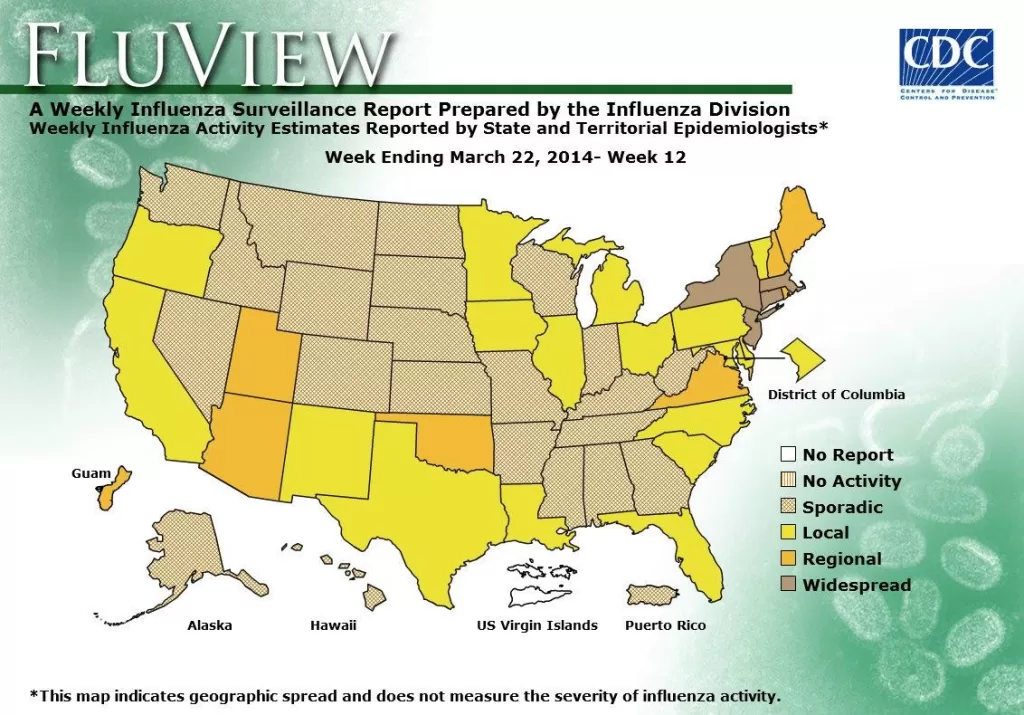Flu activity in the United States has surged dramatically in recent weeks, with the CDC flu report indicating a troubling rise in healthcare visits for respiratory virus symptoms. Test positivity for the influenza virus reached a staggering 31.6%, while outpatient visits for flu-related illnesses remained persistently above the national baseline for ten consecutive weeks at 7.8%. This escalating crisis is evident as 45 jurisdictions report flu activity classified as very high or high, contributing to an estimated 24 million infections and 310,000 hospitalizations nationwide. The alarming statistics reveal that there have already been 13,000 flu deaths this season, sparking concern among public health officials. As schools face closures across at least 10 states, the implications of this flu outbreak are profoundly felt across communities, underscoring the urgent need for vigilance and preventive measures against this infectious threat.
Recent reports on influenza activity across America highlight a significant increase in respiratory virus illnesses. The Centers for Disease Control and Prevention (CDC) has noted a frightening uptick in flu-related hospital visits, particularly among children, signaling a dire situation. Current influenza virus statistics reveal that a considerable slice of the population is affected, leading to widespread healthcare strain. The ongoing rise in pediatric flu deaths and hospitalization rates calls for heightened awareness and proactive responses from health authorities. As we navigate through this challenging flu season, understanding the broader implications for public health is crucial.
Current Influenza Virus Statistics and Trends
According to the latest report from the US Centers for Disease Control and Prevention (CDC), flu activity in the United States has seen a significant uptick. With healthcare visits for respiratory virus symptoms reaching alarming levels, the CDC’s update indicates a test positivity rate for the flu that soared to 31.6%. This statistic reflects a serious public health concern, especially as outpatient visits for flu-like illnesses also rose to 7.8%. These numbers point to a healthcare challenge as they remain above the national baseline for ten consecutive weeks, reinforcing the need for public vigilance should rates continue on this concerning trajectory.
In addition to the test positivity rates, approximately 24 million people in the US have contracted the flu so far this season, resulting in 310,000 hospitalizations and about 13,000 deaths. Multiple jurisdictions have classified the flu status as very high or high, indicating widespread transmission of the virus. Staying informed through reliable resources like the CDC flu report is crucial for understanding how the influenza virus statistics shape the current health landscape in the country.
Impact of Flu on Pediatric Populations
The latest CDC report highlights that emergency department (ED) visits for flu-related issues are predominantly seen in children aged 0 to 4 and 5 to 17 years. The rise in flu hospitalization rates significantly affects pediatric populations, which appear to be facing the highest severity compared to other age groups. In fact, the weekly report indicates a spike in pediatric flu deaths, with ten more fatalities confirmed, emphasizing that influenza still poses a serious risk to younger patients.
Thus far this season, the CDC has recorded 57 pediatric flu deaths, with a considerable number attributed to influenza A. Among various subtyped influenza A viruses, a significant proportion were identified as the 2009 H1N1 and H3N2 strains, indicating that these specific strains are contributing to the current crisis. Parents and guardians should remain aware of respiratory virus symptoms and the flu’s impact on children’s health to take timely precautions.
Flu Hospitalization Rates: A Growing Concern in All Age Groups
Frequently Asked Questions
What are the current flu activity statistics in the United States according to the CDC flu report?
According to the latest CDC flu report, flu activity in the United States has surged, with test positivity rates reaching 31.6% and outpatient visits for flu-like symptoms reported at 7.8%. The CDC classifies flu activity as very high or high in 45 jurisdictions, estimating approximately 24 million infections, 310,000 hospitalizations, and 13,000 deaths attributed to the influenza virus.
How many pediatric flu deaths have been reported recently in the United States?
Recently, there have been 57 reported pediatric flu deaths in the United States. The CDC’s weekly update indicated that ten additional pediatric deaths were confirmed, primarily linked to influenza A viruses, with the majority caused by the 2009 H1N1 and H3N2 strains.
What age groups are seeing the highest flu hospitalization rates in the United States?
Flu hospitalization rates are notably high among children aged 0 to 4 years and those aged 5 to 17 years. Additionally, seniors and adults aged 50 to 64 years are also experiencing elevated hospitalization rates, reflecting a broad impact across all age groups in the context of the current flu activity in the United States.
How does the current flu hospitalization rate compare to previous seasons?
The current flu hospitalization rate stands out with a peak of 10.2 per 100,000 population, tying with the 2017-2018 season for the highest weekly peak since the 2010-2011 season. This indicates significant flu activity in the United States during the current flu season.
What symptoms are associated with respiratory viruses during the current flu season?
Symptoms commonly associated with respiratory viruses, including the influenza virus, include cough, fever, sore throat, and difficulty breathing. The recent CDC report noted a very high level of healthcare visits for respiratory virus symptoms as flu activity in the United States continues to rise.
What impact has flu activity had on schools in the United States?
The ongoing flu activity has led to individual school or district closures in at least 10 states. This reflects the significant impact the influenza virus has had on educational institutions amidst the current surge in flu cases.
What type of influenza viruses are currently prevalent in the United States?
Currently, tests have shown that 97.4% of positive samples are influenza A viruses, with 53.7% identified as the H1N1 subtype and 46.3% as H3N2. This suggests that both subtypes are contributing significantly to the ongoing flu activity in the United States.
What precautions can be taken to reduce the risk of flu infection during high flu activity periods?
To reduce the risk of flu infection during high flu activity periods, individuals should practice good hygiene, including frequent handwashing, avoid close contact with sick individuals, stay home if feeling unwell, and consider getting vaccinated against the influenza virus to enhance immunity.
| Key Points | Details |
|---|---|
| Flu Activity Level | Flu activity in the United States is currently classified as very high or high in 45 jurisdictions. |
| Test Positivity Rate | Test positivity for flu has surged to 31.6%. |
| Outpatient Visits | Outpatient visits for flu-like illnesses have increased to 7.8%, remaining above the national baseline for 10 weeks. |
| Infection Estimates | CDC estimates indicate approximately 24 million infections, 310,000 hospitalizations, and 13,000 deaths. |
| Emergency Department Visits | ED visits for flu are very high, particularly among children aged 0-4 and 5-17 years. |
| Pediatric Deaths | An additional 10 pediatric flu deaths have been reported, bringing the total to 57 deaths this season. |
| Season Comparison | The current hospitalization rate is the highest for the week since the 2010-2011 season. |
| Influenza Types | 97.4% of flu samples were found to be influenza A, with notable subtypes including H1N1 and H3N2. |
Summary
Flu activity in the United States has significantly increased, with the CDC reporting alarming statistics concerning flu infections and hospitalizations. The latest updates show a surge in flu-like symptoms and hospital visits, particularly affecting young children and the elderly. With rising positivity rates and maintaining high levels of health concerns, urgent measures may be needed to address and manage the ongoing flu surge effectively.
The content provided on this blog (e.g., symptom descriptions, health tips, or general advice) is for informational purposes only and is not a substitute for professional medical advice, diagnosis, or treatment. Always seek the guidance of your physician or other qualified healthcare provider with any questions you may have regarding a medical condition. Never disregard professional medical advice or delay seeking it because of something you have read on this website. If you believe you may have a medical emergency, call your doctor or emergency services immediately. Reliance on any information provided by this blog is solely at your own risk.








